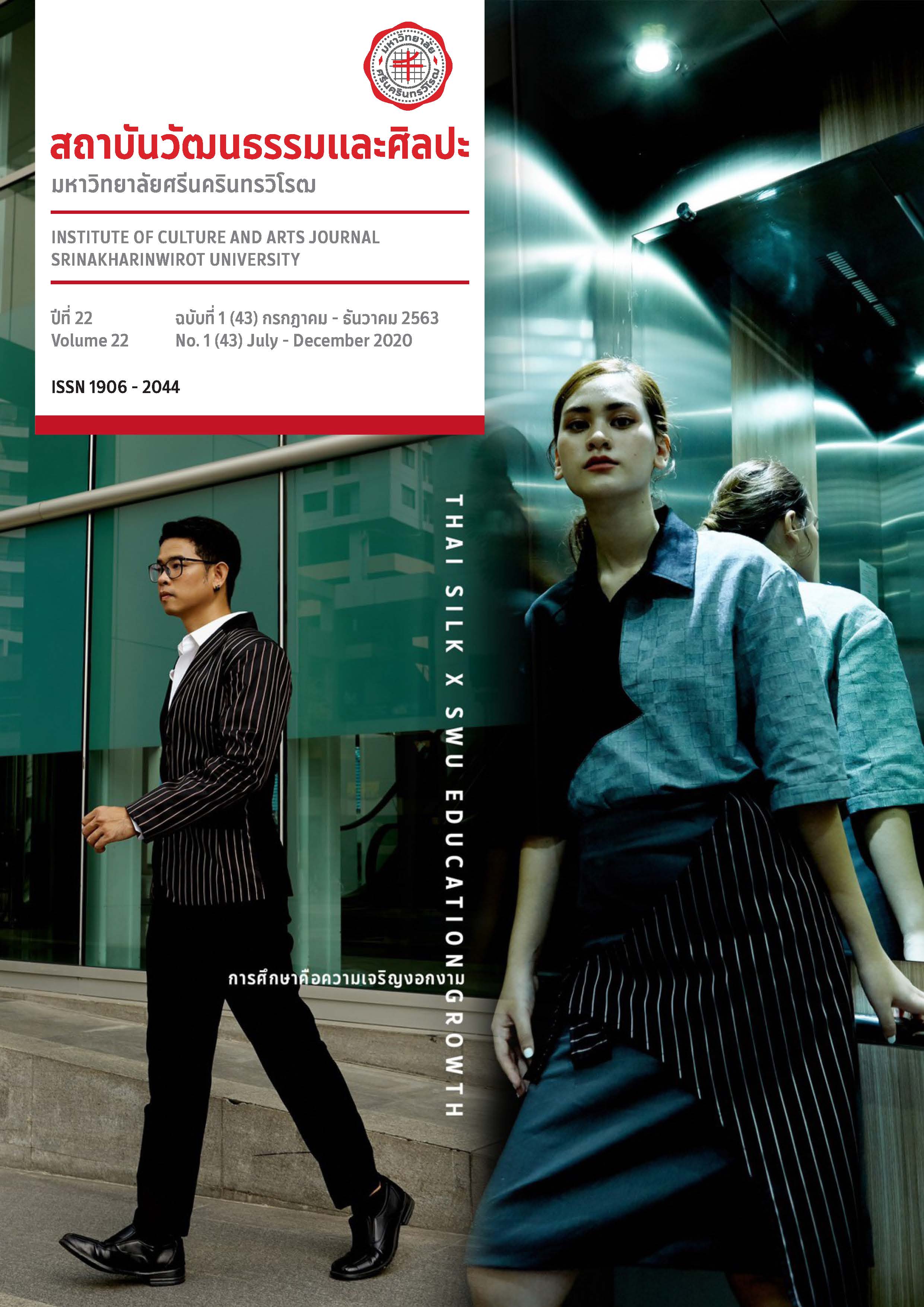นาฏศิลป์จากทรรศนะเรื่องความตายในศาสนาพุทธแบบวัชรยานของทิเบต
คำสำคัญ:
postmodern dance, creative dance, performing arts, Tibetan Vajrayana Buddhismบทคัดย่อ
The objectives of this research are: 1) to study the point of view on death in Tibetan Vajrayana
Buddhism; and 2) to create dance elements based on the point of view on death in Tibetan Vajrayana
Buddhism. This research is a creative research conducted based on the conceptual framework on
death, belief, or philosophies of Mahayana Buddhism, creative dance, semiology, postmodern
dance, choreography, and aesthetics. Data were analyzed by using content analysis and documentary
analysis. Subsequently, the analysis results were applied to create a dance performance for
presenting to public. The results revealed that dance elements could be classified into 8 elements as follows: 1) performance concept that was inspired by the belief on death of Tibetan Vajrayana Buddhism stated that death procedures of humans (human’s death) consisted of 8 procedures with only 1 chronology; 2) performers with the concept of postmodern dance as the framework for selecting performers with dance skills or skills of similar and different activities in 3 manners, i.e., contemporary dance skills, ballroom dance skills, and hip-hop dance skills. Performers consisted of 3 female performers; 3) movement using movement improvisation as the basic movement integrated with contemporary dance skills, i.e., balancing, wreathing, breathing, flexibility, and space, as well as ballroom dance skills, i.e., ballroom space, rise and fall, and hip-hop dance skills, i.e., isolation; 4) prop consisted of only 1 prop, i.e., a piece of white mesh fabric used as the symbol comparing death and living by presenting process, obstacles, and procedures of death as well as
resistance to be free from death of people left behind. White color represented peace and it was
inspired by white color of human’s bone; 5) sound and music played by a wind instrument, i.e.,
Tibetan horn, because it was played in every activity of Tibetan people in almost every occasion.
The difference between eastern culture presented through Tibetan horn and western cultural presented through piano was integrated to create sound and music with difference; 6) costumes were designed as green round-neck dresses with three quarter sleeves inspired by uniqueness of Martha Graham and green color conveyed nature or peacefulness as well as decomposition natural microorganism; 7) space that was an open space in the form of Proscenium theatre applying simplicity and it was appeared that there was no decoration, addition, or the use of any permanent fixture for promoting this performance that was compared to nature of space without any decoration; and 8) lighting using white and yellow lights during the performance integrated with some special effects, i.e., mist maker, cool color tone, because the story of human’s death was considered as an ordinary story therefore lighting of this performance focused on simplicity and clarity. The format of this creative dance was classified as postmodern dance. The researcher held this performance to present to public and there were over 250 audiences
includin students and dance teachers in primary education, secondary education, and higher
education levels, dance academicians, independent artists, and general Thai and foreign persons.
The format of this creative dance was accepted to be appropriate by public. In addition, for dance
development and creation process, the researcher was also able to lessen elements by remaining 3
important elements including performance concept, performers, and movement, because there were the
key of current dance creation. In addition, for further researches, basic knowledge obtained from
this research should be applied to create other formats of performance for making understanding,
acceptance, sacrifice, and consideration on the world through natural view based on the conceptual
framework of Tibetan Vajrayana Buddhism.
Downloads
เอกสารอ้างอิง
กิติ ยิ่งยงใจสุข. (2539). มโนทัศน์เรื่องความตายในคัมภีร์จวงจื๊อ. วิทยานิพนธ์ปริญญาอักษรศาสตรมหาบัณฑิต. ภาควิชาปรัชญา บัณฑิตวิทยาลัย จุฬาลงกรณ์มหาวิทยาลัย.
ณรงค์ คุ้มมณี. (2560). บทอัศจรรย์: นาฏยศิลป์ไทยร่วมสมัยจากแนวคิดวรรณคดีไทย. วิทยานิพนธ์ปริญญา ศิลปกรรมศาสตรดุษฎีบัณฑิต. คณะศิลปกรรมศาสตร์ จุฬาลงกรณ์มหาวิทยาลัย.
ธรากร จันทนะสาโร. (2558). นาฏยศิลป์จากแนวคิดไตรลักษณ์ในพระพุทธศาสนา. วิทยานิพนธ์ปริญญา ศิลปกรรมศาสตรดุษฎีบัณฑิต. คณะศิลปกรรมศาสตร์ จุฬาลงกรณ์มหาวิทยาลัย.
นพดล อินทร์จันทร์. (2545). กระบวนการในการออกแบบแสง. ใน การแสดงและการออกแบบ. หน้า 71-86. กรุงเทพมหานคร: ไอเดียสแควร์.
นพดล อินทร์จันทร์. (2548). ศิลปะของการจัดแสงบนเวที. ใน การแสดงและนาฏศิลป์. หน้า 77-95. กรุงเทพมหานคร: สันติศิริการ พิมพ์.
นราพงษ์ จรัสศรี. (2561, 7 มิถุนายน, 19 ตุลาคม และ 6 พฤศจิกายน). ศาสตราจารย์ทางด้านนาฏศิลป์สร้างสรรค์ จุฬาลงกรณ์มหาวิทยาลัย. สัมภาษณ์โดย ธรากร จันทนะสาโร ที่ห้องเรียนดุษฎีบัณฑิต คณะศิลปกรรมศาสตร์ จุฬาลงกรณ์มหาวิทยาลัย.
รักษ์สินี อัครศวะเมฆ. (2561, 11 กันยายน และ 8 ตุลาคม). อาจารย์ประจำสาขาวิชานาฏศิลป์ คณะศิลปกรรมศาสตร์ มหาวิทยาลัยศรีนครินทรวิโรฒ. สัมภาษณ์โดย ธรากร จันทนะสาโร ที่ห้องสำนักงานสาขาวิชานาฏศิลป์ คณะศิลปกรรมศาสตร์ มหาวิทยาลัยศรีนครินทรวิโรฒ.
วิไลลักษณ์ สายเส่นห์. (2537). การศึกษาเปรียบเทียบทรรศนะเกี่ยวกับการตายและการเกิดใหม่ในพุทธศาสนานิกายเถรวาทกับนิกายวัชรยาน. วิทยานิพนธ์ปริญญาอักษรศาสตรมหาบัณฑิต. ภาควิชาปรัชญาบัณฑิตวิทยาลัย จุฬาลงกรณ์มหาวิทยาลัย.
สทาศัย พงศ์หิรัญ. (2561, 11 กันยายน และ 8 ตุลาคม). หัวหน้าสาขาวิชาศิลปะการแสดง คณะศิลปกรรมศาสตร์ มหาวิทยาลัยศรีนครินทรวิโรฒ. สัมภาษณ์โดย ธรากร จันทนะสาโร ที่ห้องสำนักงานสาขาวิชาศิลปะการแสดง คณะศิลปกรรมศาสตร์ มหาวิทยาลัยศรีนครินทรวิโรฒ.
Acocella, J. (2011). Imaging dance. In Moving history, dancing cultures: A dance history reader. pp. 12-16. Connecticut: Wesleyan University Press.
Dils, A., & Albright, A., editors. (2001). Moving history, dancing cultures: A dance history reader. Connecticut: Wesleyan University Press.
Ham, R. (1987). Theatre: Planning guidance for design and adaptation. New York: Cambridge University Press.
Pearlman, E. (2002). Tibetan sacred dance: A journey into the religious ad folk traditions. Rochester: Inner Traditions.
Reeve, J. (2011). Dance improvisation: Warm-ups, games and choreographic tasks. USA: Human Kinetics.
ดาวน์โหลด
เผยแพร่แล้ว
รูปแบบการอ้างอิง
ฉบับ
ประเภทบทความ
สัญญาอนุญาต
บทความทุกบทความที่ได้รับการตีพิมพ์ถือเป็นลิขสิทธิ์ของวารสารสถาบันวัฒนธรรมและศิลปะ มหาวิทยาลัยศรีนครินทรวิโรฒ



